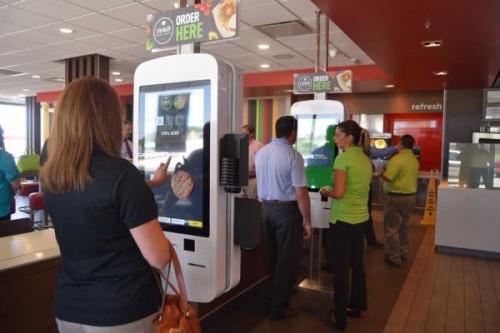
11/28/2017
Except for the really high class restaurants, low-skilled workers are adequate for the simple tasks required in food prep. As a result, automated replacements are coming on particularly strong in the food industry, particularly since some workers have been clamoring for $15/hour — bad timing there.Below, McDonalds has begun to install ordering kiosks in its restaurants to save money on labor.

In a CNBC interview earlier this year, Yum Brands CEO Greg Creed predicted robots would replace fast food workers by the mid-2020s. That forecast lines up pretty well with another projection, that big changes from automation to the workplace will show up in beginning around five years.
So much of low-skilled food and restaurant work is about to disappear, and it therefore makes no sense to continue importing cheap-labor immigrants as if the workplace is the same as it ever was. It isn’t, and admitting many thousands of soon-to-be unemployed foreigners is not a good prescription for social tranquility in the future, when sorting out the automated economy will be stressful enough without additional diversity.
The following video is pretty good at giving a good picture on the evolution of machines as applied to food production and preparation, although the Zume Pizza woman is a little devious about how automation fits into the business plan:
Here’s the associated article from Wired:
When Robots Invade the Kitchen, Wired.com, November 25, 2017BURGER FLIPPERS, PIZZA tossers, and latte frothers, watch your backs: Gordon, Sally, and Kona are coming for you. (And they never need to take a sick day.) Over the last few years, a growing army of efficient cost-cutting robots has arrived to automate a range of food prep tasks, from whipping up salads for the Palo Alto lunchtime rush to spicing late-night curry for hungry MIT coeds. They join the ranks of robo-cooks already popular in Asia; in China, there’s even a bot-staffed restaurant called Wall.E. Whether serving as sous chef in the kitchen or streamlining your takeout order, there is perhaps no better target for Silicon Valley’s appetite for disruption than the food industry.
Coffee Maker: Avoid barista side-eye by getting your coffee from a six-axis robotic arm named Gordon. Built by Mitsubishi, Gordon has been steaming and pouring espresso drinks in a glass-enclosed San Francisco kiosk, Cafe X, since January. It’s like a java ATM, minus overdraft fees.
Greens Goddess: Launched by Redwood City, California, startup Chowbotics in April, Sally is an Automat-style box filled with 21 canisters of chopped ingredients. She can create over 1,000 salad combinations — presumably while pondering the gender politics of whoever decided to name a calorie-counting salad robot “Sally.”
Pizza Machine: At Zume Pizza in Silicon Valley, robots prep dough balls into thin-crust pies, dispense and spread the sauce, and transfer pizzas to and from 800-degree ovens. The pizzas are delivered in trucks outfitted with dozens of smart ovens to keep the pies hot. The secret sauce? Predictive analytics.
Dorm ’Droid: Leave it to a bunch of MIT students to upgrade their dining hall options by designing a fully automated minirestaurant. At Spyce Kitchen, the robot chef needs less than five minutes to cook meals such as jambalaya or chickpea coconut curry. Nothing is served on a plastic tray.
Noodle Duo: Ninety-second ramen doesn’t have to come in a microwavable cup. Since 2015, twin robots Koya and Kona have been concocting made-to-order bowls at Toyako, in Shanghai. The pair can boil water, cook noodles, ladle broth, and dole out veggies, meat, and eggs in less than two minutes.
Burgermeister: Robotics company Momentum Machines has built a fully autonomous beast capable of grilling 400 burgers an hour. Though Momentum has yet to open its first location (slated for San Francisco), expectations are high — and the buns are brioche.
This is a content archive of VDARE.com, which Letitia James forced off of the Internet using lawfare.